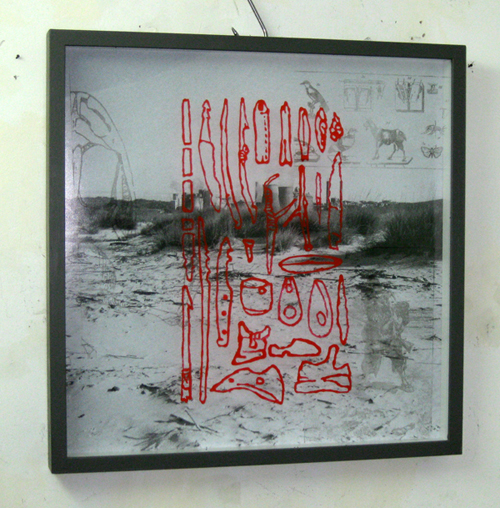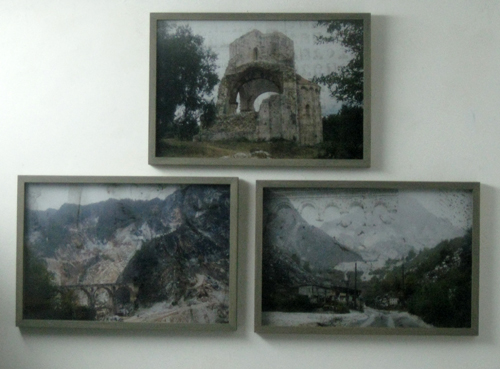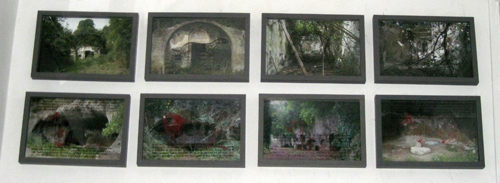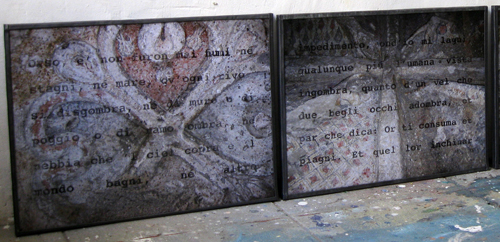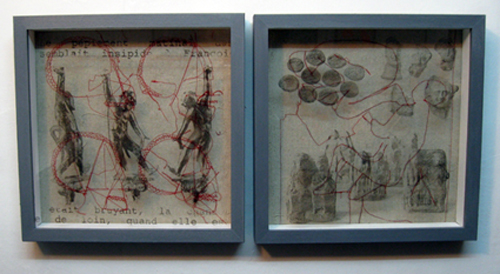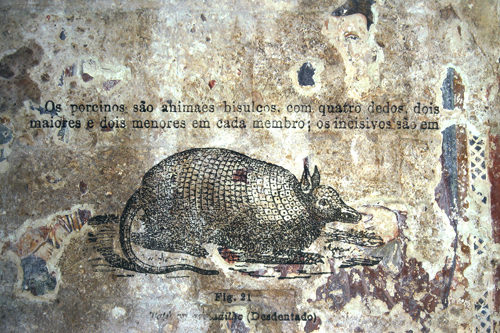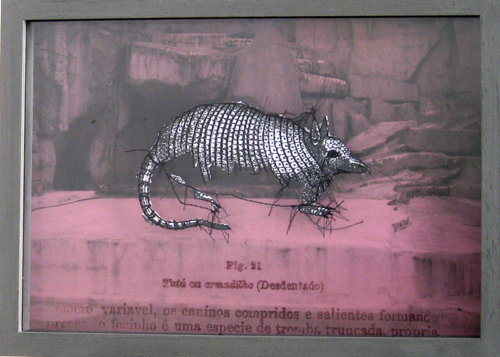The following is a survey of the sides of my work dealing with “historicized” nature and “naturalized” history.
Gulliver in Lavera, 2010
My interest in landscapes resonates with my interest in faces to the extent that both involve the same type of approach to the photographic medium. Both subjets also correspond to my interest in intermediary spaces, which are not completely natural yet not yet fully “humanized”. The photographs in this series were shot at dawn on a winter Sunday, at the industrial site of Lavera, one of the largest petrochemical complexes in Europe, built in a once-idyllic spot on the Provence coast. I will quote a passage from an article by Daniela Goeller, who speaks more eloquently than I can.
“The landscape is a complex construction. It is way of looking at an environment and exists only through the eyes of the viewer. More than a reflection of the outside world and the surrounding countryside, the landscape constitutes an ideal space for projection and reflects different artistic and political visions and concepts imposed by our civilization on nature through the centuries.” ( http://www.tk – 21.com/Gulliver -a- Lavera ).
These images comprise different layers. In the foreground, a beach view fronting some industrial buildings. Then two layers: very diluted paint drippings that creates a sort of cloud (or sun) upon drying; and printed on glass in the foreground — almost erased by the rudimentary method of transferring trichlorethylene — are engravings from Gulliver’s Travels.
The choice to re-use and “re-engrave” illustrations of Gulliver’s Travels, an allegorical and satirical work by Jonathan Swift, with other historical images, is significant: the work was written in the 18th century, the Age of Enlightenment characterized by faith in justice and progress, which are subtly mocked by Swift. It is also the century of Piranesi and the romantic fascination with ruins, which is possible only if they are considered as a nostalgic remnant and not a real possibility (Speer exercise I was talking yesterday was actually an “excercise of style”; such a vision allows ruins to be used for decorative purposes.
As a “pendant” to the previous series, I realized a few Months later a few pieces named after Robinson’s figure; you know that Swift wrote his Gulliver, among other, as a reaction to Defoe vision of a primeval natural state of humankind. On the coast of Tuscany you find a site of white sand beaches; they look like Caribbean islands, but they are created by the waste of a sodium hydroxide factory, the Belgian Solvay. These beaches are very praised by tourists in Summertime. I imagined to translate the very moment in which Robinson, not believing his own eyes, found the trace of a human feet on the sand. In my piece, though, the remnants of industrial civilisation are quite visible. (04-07)
Drum songs, 2010-2011
Somewhere in a Nordic country, urbanscapes set side by side with landscapes, the former accompanied by transcriptions from the East Greenland drum contests (the poetic duels the Inuit used to perform to resolve conflicts, to avoid killing each other), the latter accompanied by reproductions of objects retreived from the harbour, presented like scientific plates.
Marmo, 2011-2012.
In the autumn of 2011 I returned to Italy to photograph the subject of nature exploited by humans. I wanted to compile a stock of images to work on during the winter months. But I found humans submerged by natural phenomena. I encountered days of heavy rainfall and flooding in Tuscany, and the trip was unsuccessful.
I did however manage to take four acceptable photographs, in the marble quarries of the cloud-covered mountains of Cararra. On the long trip home, avoiding the highways and taking side roads, I stopped where I knew of abandoned churches, and I photographed the second image incorporated into each of these pieces: a detail of artifacts made out of perennial marble; medieval churches are among the most striking symbols of Western civilization.
So this series depicts both concavity (the quarried mountain from which the marble is extracted) and convexity (the sculpted marble of the cathedral).
Romitorio, 2011
If you hike the Fiora valley, in the Latium region just South of Tuscany, and go up and down on banks collapsed after recent floods, and you enter woodlands tangled like jungles, you can reach a couple of romitori, or hermits places, which survived the centuries, thanks to their isolation and to the little interest they have aroused in succeeding generations. Here is Poggio Conte: past a waterfall that provided drinking water to the monks, you can see the remains of two tiny cells, to which lead arduous steps carved into the tufa, and a Cistercian-inspired rupestrian church. Its interior – in spite of the oculus carved into the facade – is completely dark: if you make photographs, it will be at random, and only the film development will reveal the surviving fragments of the paintings that decorated the vaults. You will discover that this hermit from end of XIII or beginning of XIV Century (perhaps a monk of French origin?) painted the walls with decorative motifs decisively prosaic, reminding more of an interior design than of an exercise of meditation or veneration.
Nature is slowly retaking its rights; mosses and lichens cover lily flowers, red griffins and phallic shapes. Slowly disappears the work of the solitary men who spent years in shaping and covering with colors this dark cavern, being aware that very few people would ever look at them. Over my intrusive flash photos I superimposed, as a weave backlit readable, a sonnet taken from the Canzoniere of Petrarch. It speaks, in beautiful metaphors, of priceless sufferings of love. I transcribed it in a continuum, like a telex.
I don’t know if there is anything in common between this text and these paintings, apart from the fact that both poet and painter belonged to the same half a Century.
In Tuscia, 2012
The San Pietro Bridge near Farnese, after flooding; the Etruscan site of Rofalco, after archeological excavation; the tangled forest known as la Selva del Lamone, where a trail has been blazed.
These images have been reproduced on glass and superimposed on white paintings with a fluorescent shape, which creates a shift in the surfaces, endowing the work with what I consider a trace of modernity that was otherwise missing.
Rupestrian, 2012-2013
Although the term rupestrian denotes an art form ‘executed on or with rocks’ (e.g. tombs, sanctuaries, cave paintings or inscriptions), it can also refer to the process by which human-made creations fade away and become part of their surroundings.
In this sense, Rupestrian occurs at the meeting point of nature and history. In such instances, it is not only as if civilization and abandonment occurred in successive waves over the centuries; rather one was the pre-condition of the other. A natural site transformed into a “work” through human intervention is, in turn, retrieved by nature, which makes a “work” out of what remains of the initial human intervention. For me it is not so much about working horizontally in space (e.g. Land Art) as engaging vertically with time, which serves as a medium in a process of stratification ― a form of ‘reverse archaeology’.
Land paintings, 2013
I call these photographic works Land paintings. They are an attempt to respond to a question about my own presence within historical space. I have tried to define this location through the concept of “rupestrian”.
In recent years, whenever I could, I hiked around the Tuscia region, north of Rome, in a sparsely inhabited land full of prehistoric and archaeological sites, with a leaf, or a tongue, made out of latex dipped in red fluorescent pigment, leaving it on the ground, and then photographing it. The Etruscan tombs, which become medieval hermitages, then sheepfolds, then wartime shelters, finally lovers hideouts, are the usual stops of my wanderings.
In my previous work, the sign placed on the photograph was a means of preventing the fruition of the image in its entirety, of opening up a gap of time within it, using a fluorescent color that displaced the vision. This intrusive element is now a material one and becomes an art work when the photograph is taken. This is the reason why I don’t usually add other semantic levels to it.
This sign left on the sites before photographing them constitutes the landmark of my “I have been there” but also a way of seizing the baton, in a relay race with the past. And here I would simply like to recall that, in Italian, the baton is called il testimone, “the witness”.
Sometimes, though, when I was at the presence of a human construction more or less preserved, I felt the need of superimposing layers of writings and colors on the images. This series is titled Horror vacui.
Nella selva antica, 2014
a. On the Plateau. Last year a friend told me that my series of works entitled “Rupestrian” reminded her of Robert Pogue Harrison’s essay on forests (Forests. The Shadows of Civilisation, Stanford 1992). I found that book and read it but set it aside for a long time. The concept that I took from it is that the forest is a human invention, a cultural contrivance. At that time, I was thinking about my literary models of a now-gone generation who experienced the Second World War in their youth: Nuto Revelli, Primo Levi and others. The last survivor was Mario Rigoni Stern (1921-2008). Born in the Asiago plateau, an area heavily damaged during World War I, Rigoni was influenced by the nationalistic rhetoric and wanted to pursue a military career. However before long he became convinced of the injustice of the war, a conviction that was further strenghtened during his service in the Italian Expeditionary Corps in Russia, in the disastrous retreat of January 1943, and subsequently in his years of internment in a German military concentration camp.
The theme of the forest, that forest annihilated by Austrian and Italian bombs between 1915 and 1918 and subsequently replanted, exemplifying the ‘artificial’that laboriously reverts to a natural state, is central to Rigoni’s oeuvre.
As I wandered, as a tourist, around Rigoni’s homeland I recorded some images of forests, which, upon closer inspection, reveal traces of the war: the collapsed trenches, the craters created by bombs. There I encountered a theme of subject of my Rupestrian series: these sites are also taken back by nature, even if here the traces left behind are the result of humankind’s diabolical engineering rather than its creativity.
And what do these photographs have to do with the verses Dante penned to describe his entry into earthly paradise, the “ancient forest”, at the summit of the Mount of Purgatory, and his encounter with Matelda, guardian of the Terrestrial Paradise, which is free of original sin?
b. In the Lamone. Dante was certainly the last visitor to the Garden of Eden. No forest, not even the ancient forest that covered the volcanic formations of the Tuscia region in central Italy, can be considered primeval forest; even the conservation is an artificial fact. In the Selva del Lamone natural reserve, for instance, everywhere traces of human “civilization” can be found: dilapidated walls, the remains of road pavement, the furrows of the charcoal wagons, the heaps of stones that once constituted Etruscan walls, and today the strips of white and red paint on the network of trails.
My photographs are reproduced on transparent layers and superimposed on reproductions of prehistoric petroglyphs (those in Nevada are the oldest discovered on the North American continent) are the signs of an era when humankind was just beginning to appropriate nature. They are reproduced with red fluorescent acrylic paint, as a gesture of signage reminiscent of the petroglyphs used ten thousand years ago, the only difference being the technology of the reproduction.
Here you find a variation on this same subject, a serie named Eden; I just emphasized here the relation to the theme of ruins, which we were discussing previously.
c. Ferula lamonis. Ferula communis (Giant fennel) has been known by humankind since mythological times. Prometheus is said to have brought fire to humans in a fennel stalk. Moreover, a ferula stick crowned with a pinecone and decorated with vine leaves was carried by the Maenads who followed Dionysus’ cortege. Whereas its cousin, Foeniculum vulgare, is healthful, ferula is a toxic and invasive plant. Known as narthex – ‘scourge’ – in Greek, it grows in the deciduous forests of the arid coastal plains of Sardinia, Greece and the Maremma. However, unlike the ferula in Dionysian rituals, it is infertile in this environment, making it appear as a mere intruder.
Here you see some variations on the theme.
And, finally, what I find a more accomplished work on Rigoni Stern books and places, the “return to the heights”: Anabasis. I show you the different steps of my procedure, which is at a same time an ideological commitment: to constantly affirm the multiplicity of any image, as well as of any individuality.
SP, 2014-2015
